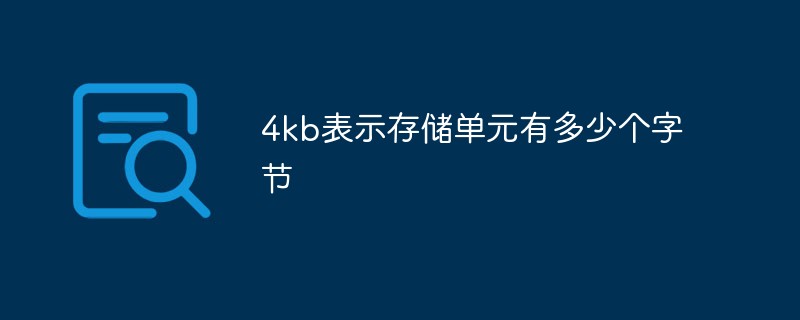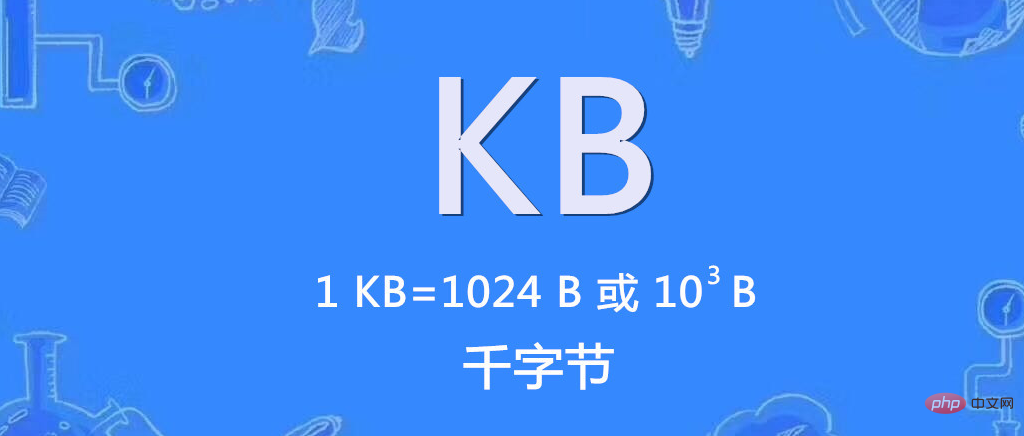4kb indicates how many bytes there are in the storage unit
4KB means the storage unit is 4096 bytes. KB refers to kilobyte, which is a multiple form of computer data storage unit byte. A kilobyte is based on the power of 2, that is, a kilobyte (1KB) is equal to 1024 bytes (B ); therefore "4KB=4*1024B=4096B", that is, 4KB represents 4096 bytes.

The operating environment of this tutorial: Windows 7 system, Dell G3 computer.
Storage capacity can be expressed in KB, 4KB means the storage unit is 4096 bytes.
The storage unit should generally have the function of storing data and reading and writing data. An 8-bit binary is used as a storage unit, which is a byte. Each unit has an address, which is an integer encoding and can be represented as a binary integer. Variables in the program correspond to storage locations in main memory. The name of the variable corresponds to the address of the storage unit, and the content of the variable corresponds to the data stored in the unit.
Byte (B)
Byte (Byte) is used by computer information technology to measure storage capacity. A unit of measurement that also represents data types and language characters in some computer programming languages.
One byte stores an 8-bit unsigned number, and the stored value range is 0-255. Like characters, byte type variables only require one byte (8 bits) of memory space to store.
Byte is the unit of binary data. A byte is usually 8 bits long. However, some older computer architectures use different lengths. To avoid confusion, in most international literature the word byte is used instead of byte. In most computer systems, a byte is an 8-bit unit of data. Most computers use a byte to represent a character, number, or other character. A byte can also represent a series of binary bits. In some computer systems, 4 bytes represent a word, which is the unit of data that the computer can efficiently process when executing instructions. Some language descriptions require 2 bytes to represent a character, which is called a double-byte character set. Some processors are capable of handling double-byte or single-byte instructions. Bytes are often abbreviated as "B" and bits are often abbreviated as a lowercase "b". The size of computer memory is usually expressed in bytes.
KB (kilobyte)
KB (Kilobyte) is an information measurement unit, which is a multiple of the computer data storage unit byte . Nowadays, it is usually used to identify the storage capacity of storage media with general capacity such as memory.
Because computer scientists have long used binary systems, a kilobyte is based on powers of two. In fact a kilobyte is 2 or 1024 bytes. KB is often used to describe disk capacity, file size, memory address and its size. Please be careful to note that due to 1000/1024 inconsistencies, common applications are sometimes approximate. For example, when the memory requirement of a program is 430KB, it means that 430,000 bytes of free memory are required to run the program - or it may require 440,320 (430X 1024) bytes of free memory.
Conversion of bytes (B) and KB (kilobytes)
1KB=1024B, so 4KB=4 * 1024B=4096B.
Other conversions: 1MB=1024KB, 1GB=1024MB.

Extended knowledge: 1KB=1000B
In the International System of Units (SI), thousands (prefix) means 1000 (10 3); therefore, 1 kilobyte represents 1000 bytes. The unit symbol is expressed as kB.
This is the definition recommended by the International Electrotechnical Commission (IEC). Kilobytes and their associated prefixes such as megabytes ( )=1000000, Jika=1000000000, etc. are used to represent the code rate unit. This is consistent with the calculation rules for other SI prefixes such as hertz and floating-point operations per second.
A typical case where this definition is applied is the Mac OS Xv10.6 file manager software. Since the release of Mac OS X Snow Leopard, file sizes have been recorded with a decimal prefix. The same goes for hard drives, USB flash drives, memory cards, and DVDs.
For more related knowledge, please visit the FAQ column!
The above is the detailed content of 4kb indicates how many bytes there are in the storage unit. For more information, please follow other related articles on the PHP Chinese website!

Hot AI Tools

Undresser.AI Undress
AI-powered app for creating realistic nude photos

AI Clothes Remover
Online AI tool for removing clothes from photos.

Undress AI Tool
Undress images for free

Clothoff.io
AI clothes remover

AI Hentai Generator
Generate AI Hentai for free.

Hot Article

Hot Tools

Notepad++7.3.1
Easy-to-use and free code editor

SublimeText3 Chinese version
Chinese version, very easy to use

Zend Studio 13.0.1
Powerful PHP integrated development environment

Dreamweaver CS6
Visual web development tools

SublimeText3 Mac version
God-level code editing software (SublimeText3)

Hot Topics
 1MB of storage capacity is equivalent to how many bytes
Mar 03, 2023 pm 05:42 PM
1MB of storage capacity is equivalent to how many bytes
Mar 03, 2023 pm 05:42 PM
1MB of storage capacity is equivalent to 2 to the 20th power bytes, or 1,048,576 bytes. MB is a storage unit in computers, pronounced as "mega"; because 1MB is equal to 1024KB, and 1KB is equal to 1024B (bytes), so 1MB is equal to 1048576 (1024 *1024) bytes.
 How many bytes does 128mb mean?
Nov 29, 2022 am 10:35 AM
How many bytes does 128mb mean?
Nov 29, 2022 am 10:35 AM
128mb refers to 134217728 bytes; the byte conversion formula is "1MB=1024KB=1048576B=8388608bit", which means that 1048576 English letters and 524288 Chinese characters can be saved; the traffic unit conversion formula is 1GB=1024MB, 1MB=1024KB, 1KB= 1024B.
 1 bit equals how many bytes
Mar 09, 2023 pm 03:11 PM
1 bit equals how many bytes
Mar 09, 2023 pm 03:11 PM
1 bit is equal to one-eighth of a byte. In the binary number system, each 0 or 1 is a bit (bit), and a bit is the smallest unit of data storage; every 8 bits (bit, abbreviated as b) constitute a byte (Byte), so "1 byte ( Byte) = 8 bits”. In most computer systems, a byte is an 8-bit (bit) long data unit. Most computers use a byte to represent a character, number, or other character.
 How many bytes do utf8 encoded Chinese characters occupy?
Feb 21, 2023 am 11:40 AM
How many bytes do utf8 encoded Chinese characters occupy?
Feb 21, 2023 am 11:40 AM
UTF8 encoded Chinese characters occupy 3 bytes. In UTF-8 encoding, one Chinese character is equal to three bytes, and one Chinese punctuation mark occupies three bytes; while in Unicode encoding, one Chinese character (including traditional Chinese) is equal to two bytes. UTF-8 uses 1~4 bytes to encode each character. One US-ASCIl character only needs 1 byte to encode. Latin, Greek, Cyrillic, Armenian, and Hebrew with diacritical marks. , Arabic, Syriac and other letters require 2-byte encoding.
 How many bytes does an ascii code occupy?
Sep 07, 2023 pm 04:03 PM
How many bytes does an ascii code occupy?
Sep 07, 2023 pm 04:03 PM
An ASCII code occupies one byte. ASCII code is a coding standard used to represent characters. It uses 7-bit binary numbers to represent 128 different characters, including letters, numbers, punctuation marks, special characters, etc. A byte is the basic unit of computer storage unit. It consists of 8 binary bits. Each binary bit can be 0 or 1. One byte can represent 256 different values, so it can represent all characters in the ASCII code.
 How many bytes does one ascii character occupy?
Mar 09, 2023 pm 03:49 PM
How many bytes does one ascii character occupy?
Mar 09, 2023 pm 03:49 PM
One ascii character occupies 1 byte. ASCII code characters are represented by 7-bit or 8-bit binary encoding in the computer and are stored in one byte, that is, one ASCII code occupies one byte. ASCII code can be divided into standard ASCII code and extended ASCII code. Standard ASCII code is also called basic ASCII code. It uses 7-bit binary numbers (the remaining 1 binary digit is 0) to represent all uppercase and lowercase letters, and the numbers 0 to 9. Punctuation marks, and special control characters used in American English.
 4kb indicates how many bytes there are in the storage unit
Feb 28, 2023 pm 12:12 PM
4kb indicates how many bytes there are in the storage unit
Feb 28, 2023 pm 12:12 PM
4KB means that the storage unit is 4096 bytes. KB refers to kilobyte, which is a multiple form of computer data storage unit byte. A kilobyte is based on the power of 2, that is, a kilobyte (1KB) is equal to 1024 bytes (B ); therefore "4KB=4*1024B=4096B", that is, 4KB represents 4096 bytes.
 Detailed explanation of the method of converting int type to bytes in PHP
Mar 06, 2024 pm 06:18 PM
Detailed explanation of the method of converting int type to bytes in PHP
Mar 06, 2024 pm 06:18 PM
Detailed explanation of the method of converting int type to byte in PHP In PHP, we often need to convert the integer type (int) to the byte (Byte) type, such as when dealing with network data transmission, file processing, or encryption algorithms. This article will introduce in detail how to convert the int type to the byte type and provide specific code examples. 1. The relationship between int type and byte In the computer field, the basic data type int represents an integer, while byte (Byte) is a computer storage unit, usually 8-bit binary data





